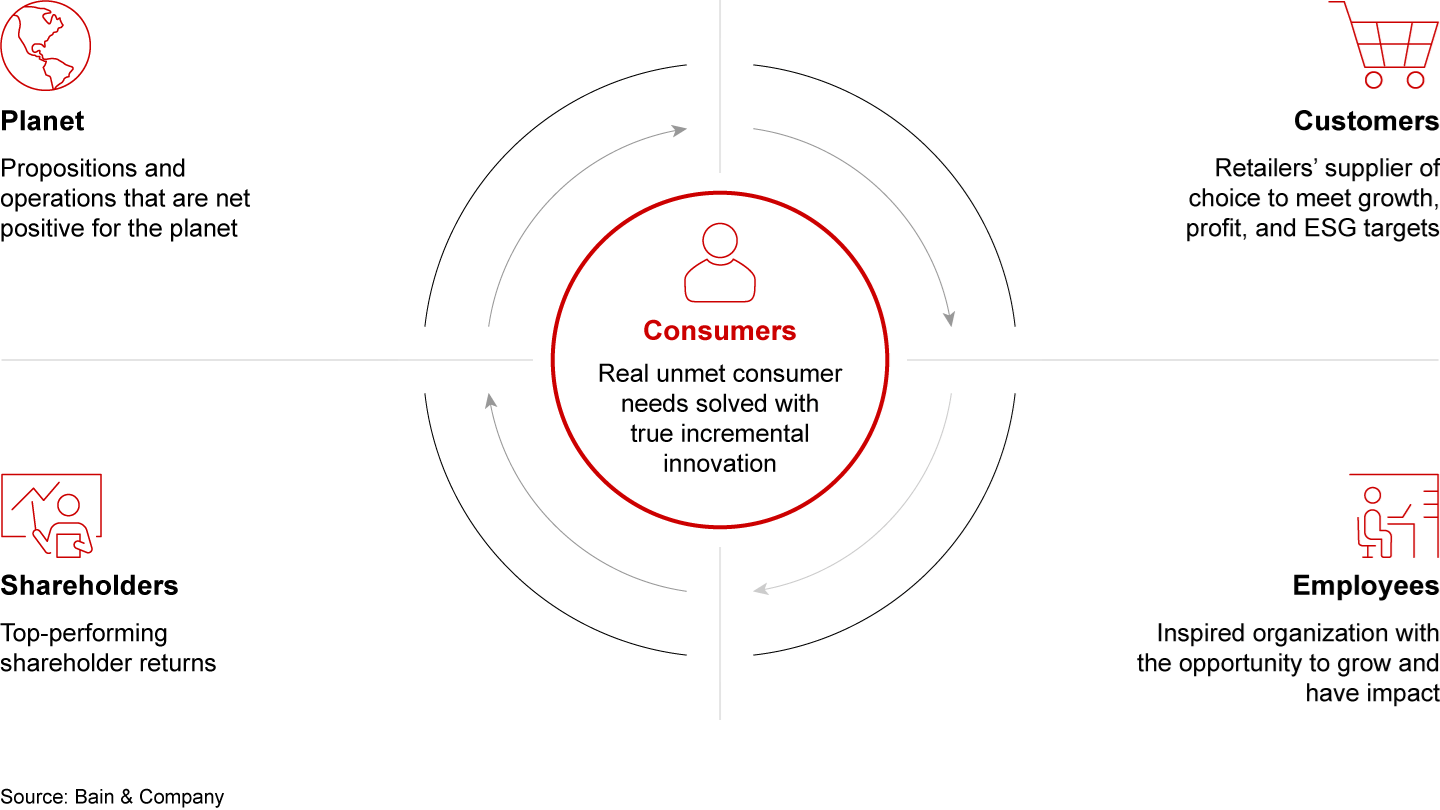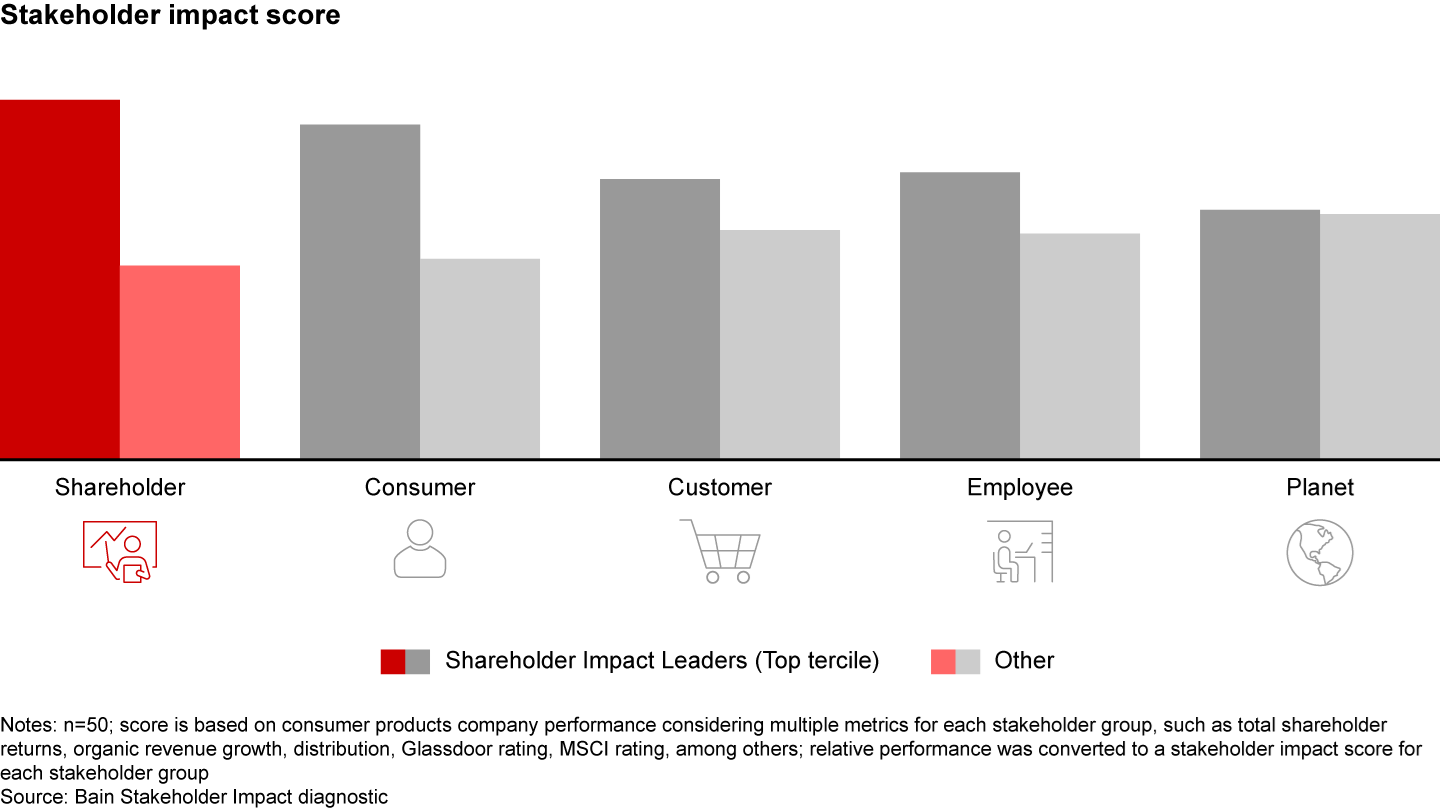Brief

At a Glance
- Aggressive cost cutting in consumer products has often protected shareholder returns at the expense of other key stakeholders.
- Serving the needs of multiple stakeholders strengthens—rather than diminishes—a company’s ability to deliver long-term value to shareholders, our research found.
- Companies that delivered greatest value to shareholders, as well as to at least two other stakeholder groups, took bold moves in five major areas.
- Those five areas are at the heart of a new transformation agenda in consumer products.
The idea that long-term growth comes from maximizing value across multiple key stakeholders isn’t new in consumer products. The industry was born from forward-thinking founders such as Unilever’s William Hesketh Lever, who introduced personal care products intended to improve consumers’ lives, and George Cadbury, who provided housing for employees, knowing that their well-being would result in greater productivity.
However, as top consumer goods companies faced low annual growth rates of 1.5% to 2.5% on average prior to the pandemic, focus turned to boosting margins to protect shareholder returns above all else. The resulting cost cuts often came at the expense of other key stakeholders—consumers, retail customers, employees, and the planet. For example, reduced investment in true innovations opened the door to consumer-focused insurgent brands capturing an outsized share of growth, while limited investments in joint business plans with retailers led to acrimonious negotiations. At the same time, headcount reduction led to capability gaps.
The pandemic was a reminder of how quickly consumer goods companies can have significant positive impact on a wider range of stakeholders. As supply challenges arose from manufacturing plant shutdowns or raw materials shortages, consumer products companies partnered with retailers to ensure consumers had basic staples available to them. Consumer goods companies swiftly pivoted supply chains to minimize out-of-stocks and gave precedence to employee safety. Those that succeeded were compensated for their efforts with greater revenue growth, employee satisfaction, and solid shareholder returns (see Figure 1).
How stakeholders benefit when companies act


To understand the implications of delivering balanced impact across stakeholders, we analyzed the performance of the top 50 consumer goods companies and found that serving the needs of multiple stakeholders actually strengthens a company’s ability to deliver long-term value to shareholders. In fact, those generating top-tier shareholder returns do so while creating value for other stakeholders, not at their expense (see Figure 2).
Leading consumer products companies deliver for stakeholders and shareholders together


To determine how consumer goods companies can succeed by serving all stakeholders, we studied the eight companies that delivered greatest value to shareholders as well as to at least two other stakeholder groups. These winning companies took bold moves—often ahead of competition—in five major areas, shaping a new transformation agenda for consumer goods companies:
- Refocus on raw consumer needs to create superior offerings.
- Redefine winning capabilities to scale, and radically simplify everything else.
- Redesign a path to net zero externalities.
- Reimagine an operating model set for speed and entrepreneurship.
- Reset the digital agenda to transform the consumer, customer, and employee experience.
We’ll look at these one by one.
Refocus on raw consumer needs to create superior offerings
With recent inflation-driven price increases reaching affordability limits, and with developing market growth tailwinds slowing, companies need to turn their attention to boosting global household penetration and premiumization to find new avenues of growth. This requires a strong understanding of the underlying raw consumer needs to reshape consumer propositions and portfolios to fit those needs. Whatever these needs may be—whether having greater social confidence or sharing memorable moments—the insights come from a consumer closeness through direct consumer interaction and mining first-party consumer data, not a reliance on syndicated data.
Keeping a close watch on the pulse of consumer trends and creating a consumer experience that responds to consumer needs is at the heart of L’Oréal’s strategy. The beauty company uses 20 local research centers and three global innovation hubs to spot local trends and rapidly scale them into global propositions. This closeness to consumers has enabled the company to reshape its portfolio to serve the areas where there is the greatest consumer momentum, leading to renovating a significant share of its SKUs each year and acquiring about 40% of its portfolio through small M&A deals such as Aesop, CeraVe, and Nanda. As a result, L’Oréal has continued to experience strong growth, particularly in its Active Cosmetics and L’Oréal Luxe business units.
Redefine winning capabilities to scale, and radically simplify everything else
In a world of increased complexity, the historic benefits of scale no longer suffice. The best companies invest to build scale only in those capabilities and in those brands or categories that will create differentiated positions within key markets. For example, many brand owners in the Korean beauty market outsource the R&D, manufacturing, and distribution of their products, focusing instead on brand building. This allows them to be extremely agile and respond quickly to consumer trends. They create value by partnering with others in the value chain that are better equipped to deliver in those areas.
This is also true for managing brand portfolios. Procter & Gamble set a standard for refocusing its portfolio only on winning subcategories and brands where it could achieve leadership positions, innovate effectively, and command higher price points. Over the course of six years, the company reduced its portfolio from 170 brands to 65, and to 10 subcategories down from 38. This allowed the iconic company to reorganize into a simplified business unit structure, creating a smaller and more agile organization closer to the front line with a greater focus on winning with consumers. Today, Procter & Gamble is the market share leader in eight of its 10 subcategories, allowing for margin expansion from 23% to 27%.
Redesign a path to net zero externalities
Consumer goods companies need to show real results on sustainability issues. The hidden costs of food and land use have grown to the point that the overall externalities risk becoming greater than the food system’s entire market value. While most companies have made bold commitments, less than a third are on track to deliver on these commitments. At the same time, retailers are seeking suppliers that can help them achieve their own sustainability goals, employees are looking for greater purpose from their employers, and markets are rewarding sustainability. Our research on Elements of Value® shows that brands scoring higher on ESG-related Elements of Value achieved 5x revenue growth compared to others.
The best consumer goods companies are aggressively hardwiring sustainability into the fundamentals of the business as a top strategic priority to the benefit of, and not at the expense of, shareholder returns. This requires an unwavering focus and a continuous effort that is CEO-championed and line-led.
Over the last five years, Nestlé has invested more than $1 billion annually to fund sustainability efforts, twice as much as the next competitor. The company is on a path to become net zero by 2050 and source 50% of key ingredients through regenerative agriculture by 2025. It is also reshaping its portfolio to meet sustainability needs through innovations such as coffee varieties with 50% higher yields and 30% lower carbon emissions. While doing so, Nestlé has sustained double-digit growth in shareholder returns.
Reimagine an operating model set for speed and entrepreneurship
All of the above requires an organization capable of striking multiple balances at once: leveraging the benefits of scale while staying close to consumers, running the business day-to-day while innovating in new areas of growth, and delivering short-term results while still achieving long-term impact. The majority of companies struggle to balance alignment, clear accountability, decision-making at the front line, and an inspired workforce, as exemplified by the absence of consumer goods companies in the Fortune 100 Best Companies to Work For and higher than average attrition rates compared with other industries.
To combine the power of scale with the deep knowledge required to win locally, Coca-Cola reorganized its business into a global networked organization. It shifted from having 17 business units to nine operating units focused on regional and local execution, with global marketing category leadership teams tasked with rapidly scaling ideas. A new platform services organization provides support for a range of critical capabilities at scale, such as consumer analytics, forecasting, and planning. This new globally connected and coordinated structure enables greater accountability and speed of execution across the front line in areas closest to the consumer. This has allowed Coca-Cola to reaccelerate top-line growth and identify key opportunities for meaningful long-term growth.
Reset the digital agenda to transform consumer, customer, and employee experience
To date, digital transformation in consumer goods has largely been a shift in spending to digital marketing and sales channels. However, the agenda for the future goes well beyond this, with digital capabilities playing a much broader role across the entire value chain. This calls for a business-led approach to delivering a user-centric experience in everything from improved consumer experiences and higher service levels with customers to greater employee efficiency and engagement.
For those who have already embarked on this journey, the next phase of digital transformation will require assessing where insufficient progress has been made on addressing these capabilities, while at the same time starting to shape an agenda for new evolutions on the horizon, such as generative AI. The greatest challenge will be balancing the investments necessary to drive growth while reducing the high IT costs that are burdening balance sheets.
When Hershey transformed its digital capabilities to substantially improve performance with consumers, customers, and the supply chain, it saw a significant uplift. For example, advanced analytics enabled the company to uncover insights that inform commercial activation, supply routing, and innovation, among other functions. During the pandemic, the company identified changes in snacking habits, such as shoppers increasingly buying single-serve candy outside of seasonal events. Based on that insight, Hershey collaborated with retailers to design and promote pantry packs, resulting in a 3% increase in multi-serve product sales volume and a 13% increase in multi-serve prices, boosting overall company performance.
With the consumer products industry facing an uncertain macroeconomic future, companies that follow these five strategic imperatives for delivering value to all stakeholders will continue to outpace those that keep their eyes solely focused on shareholders. The challenge will be where to prioritize, how to fund, and how to energize the organization for this promising new agenda.
The authors would like to thank Alexa Ellman and Bain’s Consumer Products Center of Excellence for their contributions to this work.